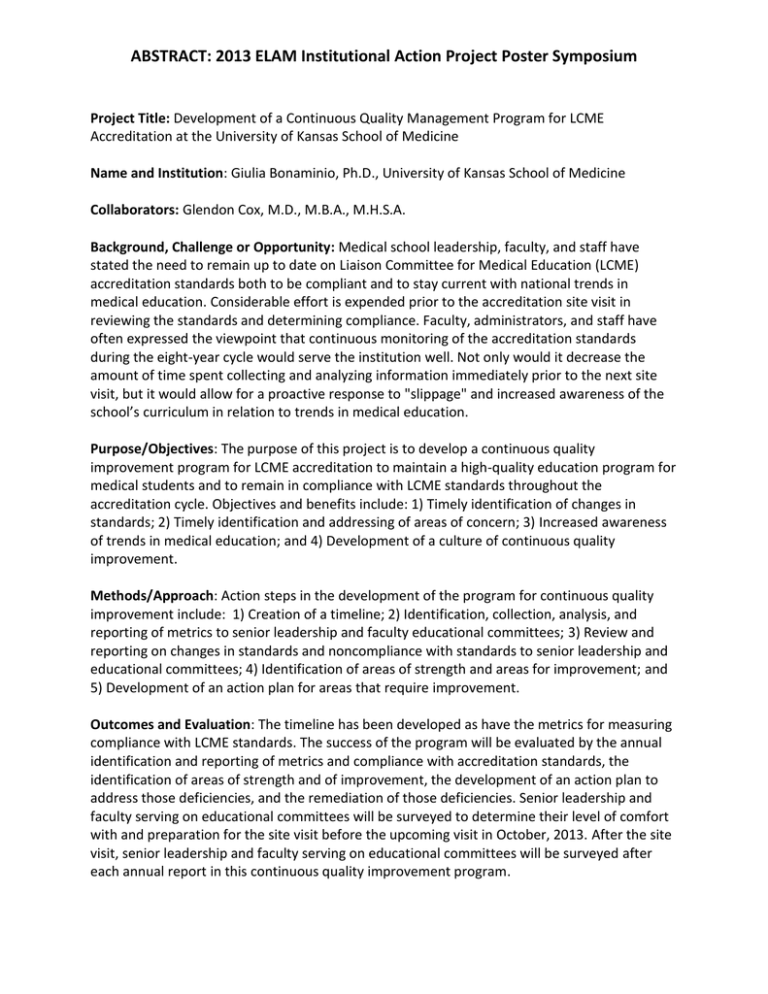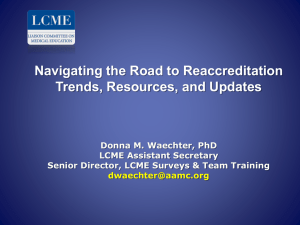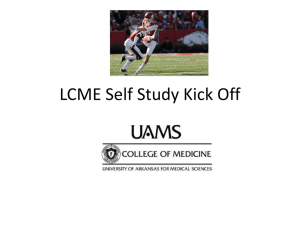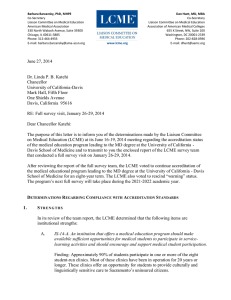ABSTRACT: 2013 ELAM Institutional Action Project Poster Symposium
advertisement

ABSTRACT: 2013 ELAM Institutional Action Project Poster Symposium Project Title: Development of a Continuous Quality Management Program for LCME Accreditation at the University of Kansas School of Medicine Name and Institution: Giulia Bonaminio, Ph.D., University of Kansas School of Medicine Collaborators: Glendon Cox, M.D., M.B.A., M.H.S.A. Background, Challenge or Opportunity: Medical school leadership, faculty, and staff have stated the need to remain up to date on Liaison Committee for Medical Education (LCME) accreditation standards both to be compliant and to stay current with national trends in medical education. Considerable effort is expended prior to the accreditation site visit in reviewing the standards and determining compliance. Faculty, administrators, and staff have often expressed the viewpoint that continuous monitoring of the accreditation standards during the eight-year cycle would serve the institution well. Not only would it decrease the amount of time spent collecting and analyzing information immediately prior to the next site visit, but it would allow for a proactive response to "slippage" and increased awareness of the school’s curriculum in relation to trends in medical education. Purpose/Objectives: The purpose of this project is to develop a continuous quality improvement program for LCME accreditation to maintain a high-quality education program for medical students and to remain in compliance with LCME standards throughout the accreditation cycle. Objectives and benefits include: 1) Timely identification of changes in standards; 2) Timely identification and addressing of areas of concern; 3) Increased awareness of trends in medical education; and 4) Development of a culture of continuous quality improvement. Methods/Approach: Action steps in the development of the program for continuous quality improvement include: 1) Creation of a timeline; 2) Identification, collection, analysis, and reporting of metrics to senior leadership and faculty educational committees; 3) Review and reporting on changes in standards and noncompliance with standards to senior leadership and educational committees; 4) Identification of areas of strength and areas for improvement; and 5) Development of an action plan for areas that require improvement. Outcomes and Evaluation: The timeline has been developed as have the metrics for measuring compliance with LCME standards. The success of the program will be evaluated by the annual identification and reporting of metrics and compliance with accreditation standards, the identification of areas of strength and of improvement, the development of an action plan to address those deficiencies, and the remediation of those deficiencies. Senior leadership and faculty serving on educational committees will be surveyed to determine their level of comfort with and preparation for the site visit before the upcoming visit in October, 2013. After the site visit, senior leadership and faculty serving on educational committees will be surveyed after each annual report in this continuous quality improvement program. Development of a Continuous Quality Management Program for LCME Accreditation at the University of Kansas School of Medicine Giulia Bonaminio, Ph.D. Glendon Cox, M.D., M.B.A., M.H.S.A. LCME CQI Annual Report Dashboard Medical school leadership, faculty, and staff have stated the need to remain up to date on Liaison Committee for Medical Education (LCME) accreditation standards both to be compliant and to stay current with national trends in medical education. Considerable effort is expended prior to the accreditation site visit in reviewing the standards and determining compliance. Faculty, administrators, and staff have often expressed the viewpoint that continuous monitoring of the accreditation standards during the eight-year cycle would serve the institution well. Not only would it decrease the amount of time spent collecting and analyzing information immediately prior to the next site visit, but it would allow for a proactive response to "slippage" and increased awareness of the school’s curriculum in relation to trends in medical education. The purpose of this project is to develop a continuous quality improvement program for LCME accreditation to maintain a high-quality education program for medical students and to remain in compliance with LCME standards throughout the accreditation cycle. New Accreditation Standard ED-19-A Action steps: 1) Creation of a timeline 2) Identification, collection, analysis, and reporting of metrics to senior leadership and faculty educational committees 3) Review and reporting on changes in standards and noncompliance with standards to senior leadership and educational committees 4) Identification of areas of strength and areas for improvement 5) Development of an action plan for areas that require improvement 10/2013 • LCME Accreditation Site Visit 06/2014 • Review standards • Review areas of noncompliance and compliance with monitoring • Review dashboard metrics 07/2014 • Present report to senior leadership and educational committees 09/2014 • Identify areas of strength and areas for improvement • Develop an action plan Objectives and benefits: 1) Timely identification of changes in standards 2) Timely identification and addressing of areas of concern 3) Increased awareness of trends in medical education 4) Development of a culture of continuous quality improvement Presented at the 2013 ELAM® Leaders Forum 05/2015 • Report on progress of action plan initiatives The core curriculum of a medical education program must prepare medical students to function collaboratively on health care teams that include other health professionals. Members of the health care teams from other health professions may be either students or practitioners. Current KUSOM activities: • Interprofessional Year 3 Family Medicine Clerkship Student Clinic • Interprofessional Year 4 Pediatrics Subinternship Simulation ED-8 The timeline has been developed as have the metrics for measuring compliance with LCME standards. The success of the program will be evaluated by the annual identification and reporting of metrics and compliance with accreditation standards, the identification of areas of strength and of improvement, the development of an action plan to address those deficiencies, and the remediation of those deficiencies. Senior leadership and faculty serving on educational committees will be surveyed to determine their level of comfort with and preparation for the site visit before the upcoming visit in October, 2013. After the site visit, senior leadership and faculty serving on educational committees will be surveyed after each annual report. ED-19




